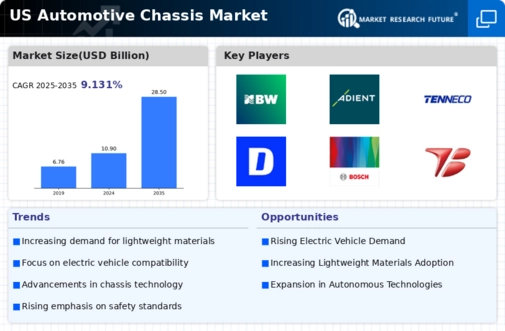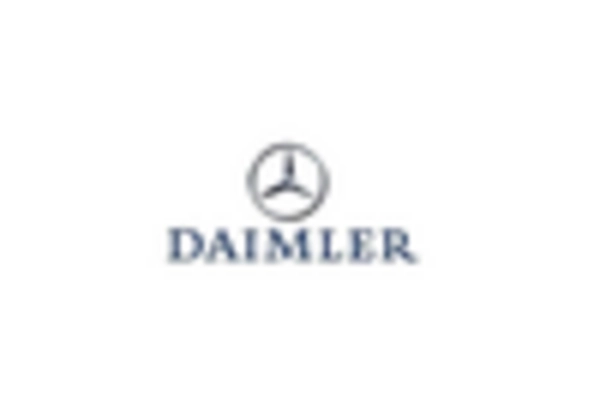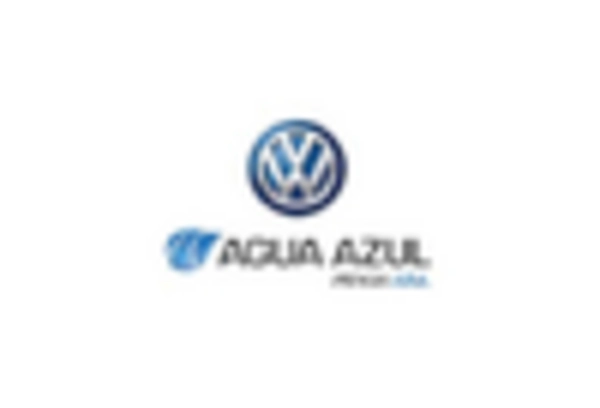Growing Demand for Electric Vehicles
The automotive chassis market is experiencing a notable shift due to the increasing demand for electric vehicles (EVs) in the US. As consumers become more environmentally conscious, manufacturers are adapting their chassis designs to accommodate the unique requirements of EVs, such as battery placement and weight distribution. This transition is expected to drive innovation in chassis materials and construction techniques. According to industry estimates, the EV market is projected to grow at a CAGR of approximately 20% through 2025, which will likely influence the automotive chassis market significantly. The need for lightweight and efficient chassis designs is paramount, as it directly impacts vehicle range and performance. Consequently, the automotive chassis market is poised for substantial growth as manufacturers align their strategies with the evolving landscape of electric mobility.
Regulatory Compliance and Safety Standards
The automotive chassis market is increasingly influenced by stringent regulatory compliance and safety standards imposed by US authorities. These regulations necessitate that manufacturers enhance the structural integrity and safety features of their chassis designs. The National Highway Traffic Safety Administration (NHTSA) has established various safety protocols that chassis must meet, which could lead to increased production costs but also drive innovation. As a result, manufacturers are investing in advanced materials and engineering techniques to ensure compliance while maintaining performance. The automotive chassis market is likely to see a surge in demand for chassis that not only meet but exceed these safety standards, thereby enhancing consumer confidence and market competitiveness.
Rising Consumer Preferences for Customization
The automotive chassis market is witnessing a shift in consumer preferences towards customization and personalization of vehicles. As consumers seek unique features and designs, manufacturers are responding by offering modular chassis options that allow for greater flexibility in vehicle configuration. This trend is particularly evident in the growing popularity of SUVs and trucks, where consumers desire tailored solutions that meet their specific needs. The ability to customize chassis designs not only enhances consumer satisfaction but also opens new revenue streams for manufacturers. As the automotive chassis market adapts to these changing preferences, it is likely to see an increase in demand for bespoke chassis solutions that cater to individual tastes and requirements.
Sustainability Initiatives and Eco-Friendly Practices
The automotive chassis market is increasingly influenced by sustainability initiatives and eco-friendly practices. As environmental concerns gain prominence, manufacturers are exploring ways to reduce the carbon footprint of their chassis production. This includes the use of recycled materials and sustainable manufacturing processes. The automotive industry is under pressure to meet sustainability targets, which could lead to a shift in material selection and production methods. For instance, the adoption of bio-based composites and lightweight metals is becoming more prevalent. This trend not only aligns with consumer expectations for greener products but also positions manufacturers favorably in a competitive market. The automotive chassis market is likely to evolve as companies prioritize sustainability in their operations.
Technological Advancements in Manufacturing Processes
The automotive chassis market is benefiting from rapid technological advancements in manufacturing processes. Innovations such as 3D printing and automated assembly lines are revolutionizing how chassis components are produced. These technologies enable manufacturers to create more complex and lightweight designs while reducing production time and costs. For instance, the adoption of additive manufacturing techniques allows for the creation of intricate chassis structures that were previously unattainable. As these technologies become more mainstream, the automotive chassis market is expected to experience increased efficiency and reduced waste, which could lead to lower prices for consumers. This trend may also encourage smaller manufacturers to enter the market, fostering competition and innovation.

















Leave a Comment